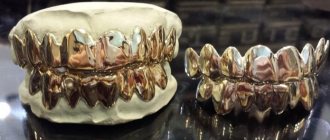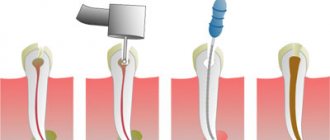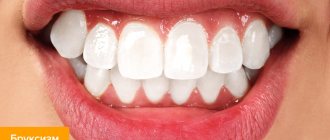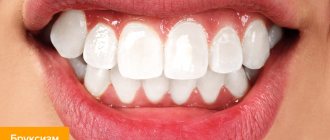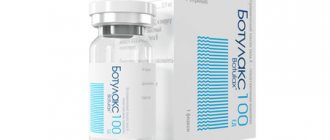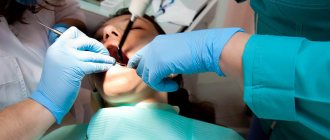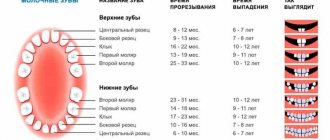Physiological explanation of bruxism
Teeth grinding occurs due to spasm of the chewing muscles, clenching of the jaws and their strong movement. The peculiarity of the disease is the fact that it occurs involuntarily. Most often this occurs during the patient's sleep at night, but some also worry during the daytime. In the first case, the pathology is called bruxism, in the second - bruxiomania. During the period of primary occlusion formation, the disease manifests itself in at least half of children. This is considered normal if it goes away by age 7.
How to treat bruxism
The approach to treatment must be comprehensive. In some cases, consultation with a psychotherapist or general practitioner is required. Only a combination of medicinal, dental, psychotherapeutic, and physiotherapeutic methods will help get rid of teeth grinding:
Botulinum neuroprotein (Botox) injections The effect of the injection increases within 2 weeks and lasts up to six months.- Sedatives
. Reducing your stress response is especially helpful in reducing involuntary teeth clenching during the day. At night this process is difficult to control, but general relaxation helps to relax the muscles. The cumulative effect is achieved after 10-12 days. - Vitamin complexes
, especially B vitamins, help reduce tension. - Magnesium
has always been used for muscle spasms; it copes well with cramps and is involved in the transmission of nerve impulses. - Physiotherapy
is aimed at relaxing the facial muscles, including the masticatory and pterygoid muscles. - Individual occlusal devices.
Mouth guards and relaxation splints show good results in the treatment of teeth grinding during sleep. Splints made of hard material are better at reducing the bioelectrical activity of muscles than soft ones.
Psychological methods help cure bruxism: relaxation, meditation, psychotherapy - all these techniques help relieve tension. But a special place in the scientific literature for getting rid of severe teeth grinding at night is given to sleep hygiene. It is necessary to avoid stimulants: coffee, tea before bed, blue light from phone and computer screens. Walking, reading paper books and a routine are recommended.
Symptoms of Bruxism
Grinding of teeth during sleep is the main symptom of bruxism. Most often, the patient does not notice this symptom on his own, and complaints from loved ones and relatives become the basis for contacting a doctor. At night, the disease manifests itself as short-term attacks of grinding or chattering of teeth, excessive tension in the masticatory muscles. It is also possible to increase blood pressure and increase heart rate during an attack. A person does not wake up from this, so he cannot remember how he is feeling.
During the day, indirect signs of bruxism appear, which can also be the basis for a diagnosis. These include:
- headaches, dizziness, drowsiness and fatigue;
- pain in the temporomandibular joint, fatigue of the masticatory muscles;
- with a long course of the disease - pathological abrasion of dental surfaces, increased sensitivity of teeth, the appearance of chips and cracks in the enamel;
- it is possible to develop periodontitis (inflammation of the tissues surrounding the teeth), as a result of which the teeth begin to loosen and fall out;
- During an attack of bruxism, there is a significant load on the dental surfaces, which can cause chips of fillings, crowns, restorations, as well as cracks or complete breakage of dentures.
Teeth grinding at night is not just a dental problem. Patients who suffer from regular bouts of bruxism develop temporomandibular joint dysfunction. Painful sensations appear in this area, which intensify while moving the jaw, when talking or eating. The chewing muscles are symmetrically inflamed and increased in volume, tense. The pain can spread not only to the temporomandibular joint area, but also to the person’s neck and shoulders.
In some cases, constant grinding of teeth causes damage to the oral mucosa. In such patients, the disease is accompanied by gingivitis - inflammation of the gums. There is also a risk of developing lichen planus, growths (fibroids) in the mouth, a scalloped tongue (scalloped), as well as scratches and abrasions if you wear dentures.
Psychosomatic causes of pathological tooth wear. Bruxism
A recent story in the media about how a dentist allegedly pulled out 22 healthy teeth from a patient prompted me to write this article. A woman who came to the clinic with the problem of temporomandibular joint dysfunction received complex orthopedic treatment, but did not experience relief. From a technical point of view, the work was done correctly. Why was there no positive effect from the treatment? Let's try to figure it out.
So, the patient was diagnosed with pathological tooth wear and dysfunction of the temporomandibular joint.
What is the root cause, did tooth wear lead to dysfunction, or did problems in the joint provoke wear?
Let's turn to the medical literature.
“Pathological abrasion of teeth is a dental disease, which is characterized by an abnormally intense reduction in the hard tissues of the tooth and a violation of the anatomical shape of the tooth crown. Recently, pathological tooth wear has become an increasingly common problem. This disease already affects about 12% of people (most often men) and this number is gradually growing.”
Consequences of tooth wear:
- Distortion and destruction of the surface of the teeth, resulting in the formation of sharp edges of tooth enamel, which can injure the tongue, as well as the mucous membrane of the cheeks and lips
- Changes in tooth height (with further development of the disease), leading to malocclusion and distortion of the shape of the lower part of the face
- Changes in the position of the temporomandibular joint, which can cause various types of jaw injuries
- Increased sensitivity of teeth to various types of temperature, chemical and mechanical stimuli (hot, cold, sour, sweet foods, etc.)
I want to write a separate article about the temporomandibular joint later; this topic is worthy of a separate discussion.
According to my observations, the percentage of people susceptible to this disease is much higher. I would put the figure at 70% among older men. The saddest thing is that this disease has become much “younger” and women have also become susceptible to this pathology.
Among the causes of pathological abrasion are malocclusions, endocrine diseases, and metabolic diseases. However, most sources cite bruxism as the cause.
Bruxism is the grinding of teeth at night (bruxism itself) or during the day (bruxomania). There are several reasons, but most researchers are inclined to believe that the cause of bruxism is psychological (stress). I have not found a more detailed description of the causes of bruxism in the scientific literature. In my opinion, the reason for this gap is the lack of interaction between psychologists and doctors of other specialties, especially dentists.
Unfortunately, current practice shows that dentists often perform only mechanical work to solve dental problems, without going into the sections of general medicine, and the psyche is a “dark forest” for us.
As the doctor from the great film said, “the head is a dark object and cannot be examined.”
However, recent events show that dentists should still have an understanding of the psychological and psychosomatic causes of various diseases, and this information can also be very useful for patients.
Grinding teeth
(Characteristic sound when eating or without chewing.)
From a psychosomatic point of view
A person strives to escape self-expression without consciously wanting to do so. He refrains from expressing discomfort or irritation. He is in conflict with himself or with others, but refrains from saying so.
Dynamic bruxism
People who grind their teeth involuntarily do so primarily at night, when alertness is reduced. The problem may appear suddenly (intense stress) or last for many years.
The psychosomatic cause of this disease is a major conflict between the mind and emotions, the “adult” and the “child” in their consciousness, one trying to dominate the other. A person who is at odds with himself, without achieving harmony, is unable to reconcile reason and passion. The spontaneous voice (I like, I want) is opposed by the voice of reason (I have a duty, I must).
Torn between desire and duty, a person “eats” himself, not daring to act in one way or another. Feeling anger that cannot be expressed, he seeks to destroy himself, but at the same time the person is possessed by the enormous power of life that he holds back.
Bruxism is characterized by various jaw movements that occur due to various reasons.
Lateral (lateral or transverse movement): the person does not know how to act. He is torn because he does not know whether to choose one path over another to get out of the internal conflict in which he is blocked.
Propulsion (or movement in an anterior-posterior direction): a person hesitates to take action to express his aggressiveness through words or gestures.
In teenagers and young adults, bruxism means rebellion that cannot be expressed. A teenager cannot “show” his teeth to his parents or at school. He must restrain his aggression, physical or verbal.
Children under 6 years of age: The child demonstrates an existing hidden conflict between his parents. The reason is an attempt to choose between parents; it reflects unexpressed relational tension. The child unsuccessfully tries to reunite (in the case of a physical divorce) or reconcile the parents (in the case of an emotional divorce). It perceives and reflects the imbalance of power between the parents, with one seeking to dominate the other or being too intrusive. For example, family life is not going well, but the parents decide to save the family for the sake of the child, the parents act (so they think) as if everything is in order.
Unconsciously, the child senses disagreement, and this manifests itself in teeth grinding. One solution is to verbally express the conflict, explaining to the child that not everything is good between mom and dad, but they are his parents, and they will always love him, and especially that the attitude towards him has nothing to do with the conflict between them.
Children over 6 years of age: The child expresses a relational conflict with one of the parents. He seeks to remove the parent against whom he does not dare or cannot express strong anger.
Also, this problem occurs in young people who undergo orthodontic treatment. Orthodontic treatment changes the balance of one's teeth; wisdom teeth extraction weakens the temporomandibular joint. In addition, the challenges of growing up and the stress of being a student cause problems: a young person's entry into adulthood brings a period of turmoil; he does not yet know his place in life. He may experience stress associated with distance from his parents (moving to another city for study); or, for example, he goes to study in a specialty that does not suit him, in order to please his parents, to be reasonable, to have a good profession, etc.
The voices of reason and passion in him manifest themselves in the form of a strong clenching of the jaw in protest. If, otherwise, he decides to follow his desires and his mind protests, he experiences a feeling of guilt and his remorse manifests itself in gnashing of teeth. If he has lost his bearings, if he realizes the differences between his desires and his choice of profession, it is better to pause in his studies in order to give himself time to find a path that would be to his liking.
It's better to lose a year than your health. Otherwise, ultimately everything will end sadly. And a problem with teeth is the most harmless of possible consequences.
Spot clenching of teeth
The density of temporary clenching of specific teeth is due to intense concentration or temporary stress. A person must find solid support in it, be it stability (molars), strength (canines), or sharpness of reaction (incisors).
Clenching your teeth appears as a way to gather all your strength and at the same time not allow fear to invade. This allows the body to mobilize its physical strength, its combat resources.
Chewing
In the article, the chewing process is considered due to the desire to chew or gnaw something, and not in the order of the chewing process when eating food.
The act of chewing is associated with the fact of presence in this world. Whatever we chew, in the way we chew we can read the pattern of behavior and the need that we feel. The data below provides some clues to interpret each individual case.
Need to chew
Extortion of the jaw muscles, especially the masseter, under vigorous exertion.
Chewing gum, for example, is a dynamic way of evacuating tension associated with daily stress. A person compensates for the need for action and unsatisfied activity. He tries to overcome his feeling of being paralyzed or helpless when faced with negative circumstances on a daily basis.
If, when chewing gum (or when trying to chew a lollipop or candy), mostly separate teeth or even one is used, this is an attempt to evoke certain moral qualities in oneself. The habit of chewing gum is associated with the need to maintain your personal space and express the capabilities associated with specific teeth. For example, chewing primarily with fangs is an attempt to call upon one's own hidden powers.
Chewing with molars (the chewing teeth are located at the back of the jaw to prepare food directly for swallowing).
Chewing teeth are very powerful, chewing with them is a way to feel strong support and stability, a way to feel the reassuring presence of your parents.
The person seems to receive a message that he is safe and has firm guidelines.
Chewing gum, as if pushing the incisors: a person is not able to self-actualize or realize an idea. He is nervous about the possibility of not finding the right words or not being heard. He would like to be understood even before he had time to express his thought in words.
Chewing on premolars (chewing teeth, mainly located in the middle of the jaw).
A person who strongly uses his premolars is going through a difficult period of transformation, such as adolescence. Or he wants to take a step in his life, to change psychologically, but he cannot. He is impatient because he wants quick results with minimal effort.
Or, the use of specific teeth may be a warning to the body about possible emerging problems in an organ or organ system.
Pen or pencil
The person refuses to see that he is under stress. He tries to take revenge for the reprimands he suffered as a child, which leads to the desire to do a better job than his capabilities allow. He risks ruining himself with the desire to do everything well. Instead of being Zen and investing in relaxation, he chooses to trust his jaw muscles to evacuate stress.
Some kind of hard object
The person does violence to himself. He knows that he is not competent in a certain area, or is not able to control the situation, but he has taken responsibility.
Tobacco
A habit that leads to the destruction of cheeks and gums by cancer.
Man seeks to destroy the breath of life in him. His instincts live within him, but he is afraid to show them because he is convinced that those around him will reject him or even want to kill him if they find out what a monster he is. He is in mourning for the maternal warmth and affection that he never had. He feels hopeless of ever getting it. And, although he instinctively feels this is unfair, he considers himself unworthy to live and be loved.
Jaw position
Under the influence of neuroleptics, the jaw drops. Yawning reflects extreme fatigue and also causes the jaw to drop. Death is characterized by a dropped jaw.
The movement of the jaw reflects the way in which one tries to manage internal contradictions.
It reminds us that life is an element of struggle. To be alive is to accept two forces that oppose and complement each other. When one of them ceases to appear, the teeth can no longer meet, the lower jaw hangs... because the person is dead.
Jaw pain
The pain is insignificant, suddenly arising and spontaneously stopping, associated with the period of life. The body or our subconscious mind warns of temporary serious disharmony, but it is better not to take it seriously.
Decreased jaw tone
For reasons of decreased general tone, reactivity, or taking antidepressants or sleeping pills. Lack of tone and reactivity, a person floats with the flow. His attitude towards life is passive. His life is directed towards others: his mother or the person who psychologically takes her place. A person limits his vital resources and instincts. He loses interest in his life, practically becoming a zombie. Risk of depression or accident.
Jaw clenching
Extreme mobilization of the masseter muscle, one of the strongest muscles in the body. When a person is stationary or immobilized, the masseter muscle alone is able to contract to provide the active movement that the body needs. The state of jaw tension reflects a way of understanding life:
- static,
- in the fight
- in the fair mobilization of forces or
- in giving up the fight.
The chewing muscle tenses when there is an internal or external struggle, you need to act, fight, concentrate. The muscle increases in size when a person must defend himself or imagines that his life is under threat. It mobilizes enormous forces in a static way (tension) or a dynamic way (chewing gum, grinding teeth). Relaxation of the masticatory muscle during effort (for example, sprinting) has the opposite nature. Relaxation requires a lot of concentration. Relaxed masticatory muscles in athletes free up the spine and help concentrate energy for the main activity. However, it is not recommended for people who are not athletes to imitate them because it can make it difficult to evacuate good stress. Anti-anxiety medications, which relax the muscles of mastication (jaw hanging), block the release of tension and prevent a person from accessing their inner strength. As for relaxation, whether it is a refusal to fight or stress, this can lead to the movement of symptoms, tension evacuation to other parts of the body (stomach ulcer for example.)
Clenching of the jaw as a reaction to an event
It should be differentiated from constriction of the jaws, which occurs reflexively, involuntarily, and differentiated from permanent tension of the masticatory muscles.
A person restrains himself from screaming and the desire to bite and break everything. He feels that he will never be heard. Tension of the masticatory muscles is a way to channel your anger, to contain your emotions, to avoid overload, to find some kind of relief.
Thus, understanding the causes of pathological tooth wear can help avoid such unpleasant consequences during dental treatment as chipped restorations (synthetic and ceramic), functional overload of supporting teeth and implants, as well as aggravation of temporomandibular joint dysfunction.
After all, without eliminating the true cause of the disease, both the doctor and the patient are doomed to endless alterations, which are unlikely to be successful without harm to health.
Bibliography:
- Lee WC, Eakle WS "Possible role of tensile stress in the etiology of cervical erosive lesions of teeth." — J. Prosthet. Dent., 1984, Vol. 52, no. 3.
- Psychosomatic Consultation in Dentistry M Ruel-Kellermann. Chir Dent Fr 53 (224), 53-54. 1983 Nov 10
Possible causes of the disease
Bruxism can occur in patients of any age. If in childhood it is associated with teething and bite formation, then in adults it has several theories of origin. The disease can be a dental, psychological, neurogenic problem, and is also studied in the field of otolaryngology. Since a single cause for the development of this pathology has not been established, several theories of its development have been identified.
| Theory | Definition |
Psychological | Many doctors are of the opinion that teeth grinding at night occurs due to a violation of psycho-emotional balance. The cause of involuntary spasm of the masticatory muscles can be either negative events and stress, or strong positive emotions. During the day, patients experience emotional instability, which may also be associated with old events. |
Neurogenic | Another theory for the development of bruxism associates the disease with disruption of the central or peripheral nervous system. Its proof is the fact that teeth grinding often occurs in combination with headaches and insomnia, somnambulism, and sleep apnea (short-term cessation of breathing during sleep). Advanced forms occur against the background of nocturnal enuresis and can be complicated by attacks of epilepsy or muscle tremors (involuntary contraction of the body muscles). During the diagnosis, organic lesions of the trigeminal nerve are detected. |
Dental | Bruxism can be a consequence of pathologies in the structure and functioning of the dental system. Regardless of age, the disease can occur due to malocclusion, dental disease, or prolonged wearing of incorrectly fitted dentures or crowns. Anomalies in the structure of teeth are also included in the list of possible causes of bruxism. |
Osteopathic | Some experts consider spasms of the masticatory muscles as a protective mechanism of the body. Thus, in children this phenomenon often manifests itself after a complicated birth with possible weakness of the skull bones and sutures. Many adults who suffer from regular attacks of bruxism are often simultaneously diagnosed with osteochondrosis of the cervical spine. Osteopathic pathology also identifies incorrectly performed dental prosthetics as one of the causes of night grinding. |
Other reasons | Another theory, which, however, has no evidence yet, is teeth grinding due to impaired nasal breathing. Thus, attacks can occur in people with a deviated nasal septum and difficulty passing air through the nasal passages. In addition, the presence of adenoids and frequent colds, which manifest as rhinitis (runny nose), may be important. |
The causes of bruxism are determined individually. It is possible that the disease will develop due to a combination of several factors at the same time. The problem of night grinding continues to be studied by leading doctors around the world. In particular, specialists from the Clinical Institute of the Brain successfully diagnose this disease and determine its causes on an individual basis.
Causes.
The causes of bruxism are not fully understood. According to most researchers, bruxism more often occurs in people experiencing stress, psychological disorders that lead to internal anxiety, anger, tension, and an excited state before bedtime. In addition, the causes of bruxism can be sleep disorders, namely somnambulism, enuresis, nightmares, snoring and periods of respiratory arrest during sleep.
As a rule, the diagnosis is established on the basis of anamnesis. The patient may complain, in addition to teeth grinding, of muscle and joint pain in the lower jaw. The diagnosis can be confirmed using a polysomnographic study, which records the contraction of the masticatory muscles. Polysomnography is also important to exclude epilepsy as a causative factor of bruxism.
Diagnostic methods
Since bruxism is considered a polyetiological disease, before starting its treatment it is important to conduct a comprehensive diagnosis. To begin with, a standard procedure is prescribed using brux checkers. These devices are mouthguards to be worn at night. After the patient wears them overnight, the impression is sent to the dentist for analysis. This way you can determine which teeth are experiencing overstrain, and how much the disease is related to the bite and location of a person’s teeth.
In order to diagnose pathologies of the masticatory muscles, electromyographic analysis is used. This research method will allow you to assess the condition of the muscles at rest and in motion. This way you can determine myofascial pain syndrome, and by the location and function of the muscles, you can identify incorrectly selected and installed prostheses. In children, the mechanism of development of the disease is often associated with the process of teething. Symptoms of bruxism will help parents identify and pay attention to their child’s malocclusion in the early stages.
You may need to consult a neurologist, otolaryngologist, psychotherapist, or maxillofacial surgeon. Based on the data of a comprehensive examination, a final diagnosis can be made and a suitable treatment regimen can be prescribed. The Clinical Brain Institute employs qualified specialists who have successful experience in treating bruxism in patients of all ages. There are also all conditions for examination using instrumental methods.
Types of bruxism
There are three forms of bruxism:
- Noisy or chopping bruxism. Teeth grinding occurs when the chewing muscles and lower jaw move. The long course of the disease is dangerous due to pathological abrasion of teeth.
- Silent bruxism or clenching of teeth. A typical symptom is a tightly clenched jaw without any extraneous sounds. To a lesser extent provokes enamel loss. More often leads to the formation of cracks in tooth enamel.
- Mixed form. Combines the characteristics of the two forms described above.
Depending on the time of occurrence of teeth grinding, bruxism is divided into daytime, nighttime and combined (episodes are repeated regardless of the time of day).
Treatment of bruxism
The treatment regimen is selected individually, taking into account diagnostic data and the patient’s age. In children under 6-7 years of age, the disease does not require emergency intervention. The patient is monitored by a dentist, but all symptoms in most cases go away on their own, without treatment.
In adults, when signs of bruxism are detected, a set of methods is prescribed. They depend on the form of the disease and its severity, as well as accompanying symptoms. The treatment regimen may include several areas:
- correction of bite and elimination of dental defects;
- drug therapy;
- psychotherapy;
- relaxation techniques;
- massotherapy.
At the first stage, it is important to eliminate all dental problems that can cause spasms of the masticatory muscles. Modern medicine allows you to correct your bite with the help of rigid fixation devices, which also help with anomalies in the location of individual teeth. Missing fragments are successfully replaced with prostheses or implants - the prosthetic method is selected individually. Selective grinding of tooth surfaces may also be necessary. First, it is necessary to completely eliminate those pathologies that interfere with the normal functioning of the temporomandibular joint. When all the symptoms of night grinding disappear, you can begin to eliminate aesthetic problems: restoration of defects, installation of fillings or veneers. Treatment of periodontitis also occurs after the attacks of night grinding stop.
To stop attacks, a course of drug therapy may be necessary. It includes sedatives and sleep aids. Solutions of magnesium, calcium, and B vitamins are also effective - they have a positive effect on the processes of neuromuscular conduction and normalize the functioning of the central nervous system. Treatment tactics are aimed at reducing the manifestations of convulsive syndrome.
The use of soft mouth guards may be necessary as symptomatic therapy. They are made of rubber or soft plastic and perform a protective function. These devices are designed to be worn at night, when the patient cannot control the functioning of the chewing muscles, and spasms occur involuntarily. Soft materials prevent abrasion of dental surfaces and the development of dangerous complications. However, they cannot reduce the frequency of attacks or prevent their occurrence.
Additional methods for treating bruxism
The psychotherapy method is considered effective for bruxism. Attacks of teeth grinding often occur against the background of a weakened psycho-emotional state, so self-control and relaxation practices come to the fore. The approach to each patient is determined individually by the doctor. It may be impossible to discover the root cause of problems on your own.
At home, you can massage your jaw, neck and chin. You should perform smooth movements with your fingers in the upper part of the neck, as well as on the side surfaces of the jaws. The procedure should not be accompanied by painful sensations. Its essence comes down to mechanical relaxation of muscles, as a result of which their spasms occur less frequently. Exercise therapy, a simple set of exercises to increase muscle elasticity, has a similar effect. Throughout the day, it is important to ensure that you keep these muscles relaxed and do not clench your jaw.
Breathing exercises are also useful. It allows not only to cause relaxation of the masticatory muscles, but also to ensure a sufficient supply of oxygen to the tissues of the nervous system. These exercises are also part of the system of self-control practices that are recommended for involuntary teeth grinding. At home, it is enough to practice deep breathing: air is slowly inhaled through the nose so that it fills the lungs as much as possible, and then exhaled through the mouth.
Causes of chin tremor
Parkinson's disease
For Parkinson's disease, a resting tremor that occurs with complete muscle relaxation is pathognomonic.
Its development is explained by the presence of central oscillators (sources of rhythmic activity), caused by a slowly progressing degenerative process in the central nervous system. This leads to the loss of dopaminergic neurons in certain areas of the brain stem: the substantia nigra, locus coeruleus, and others. But the exact reason for the changes still remains unknown. Most often, parkinsonian tremor can be detected in an elderly person; tremor of the chin, lips and limbs increases with excitement and mental stress, decreases or completely disappears with active movements, and is absent during sleep. As the disease progresses, rigidity, plastic hypertonicity, and slowness of action (bradykinesia) develop. Facial expressions are poor, patients move with a shuffling gait in a hunched position.
Familial chin tremor
Isolated chin tremor or geniospasm is considered a variant of essential tremor. This is a rare hereditary disease that is transmitted in an autosomal dominant manner. Its main symptom is an intermittent tremor of the chin, which increases with emotional stress and crying.
Trembling appears in the first days after birth or within several years. Intense tremors can interfere with drinking and speech functions. Sometimes the clinical picture of the pathology is supplemented by sleep and behavioral disorders. The course of geniospasm is long, with age the number of episodes decreases.
Neonatal tremor
Tremor is the most common abnormal movement associated with the neonatal period. In the first week of life, almost all children experience fine tremor, which is part of the structure of transient adaptation syndromes. Trembling of the chin is the result of an increase in neuro-reflex excitability due to the activation of stress mechanisms in response to transient hypoxia and physical stress during childbirth.
Mild or moderate changes in the functions of the nervous system are also due to extracerebral causes - unstable intestinal function, dysmetabolic conditions (hyperbilirubinemia, hypoglycemia). In addition to trembling of the chin, such transient disorders can manifest themselves as tremors of the limbs and changes in behavior. After the early neonatal period, all these symptoms disappear.
In premature babies, small, intermittent tremor occurs due to immaturity of the central nervous system. Other signs include decreased motor activity, muscle hypotonia, and mild squint. Usually these changes are short-term, their duration largely depends on the degree of prematurity. Tremor can be observed when screaming, due to hunger, in the REM sleep phase, and should completely disappear by three months.
Perinatal CNS damage
If chin trembling persists in a child a week after birth, is intense and is accompanied by other symptoms (general or focal), perinatal damage to the nervous system is usually diagnosed. This syndromological diagnosis hides a fairly large group of pathological conditions:
- Perinatal encephalopathy.
Perinatal hypoxia with decreased cerebral blood flow provokes cerebral damage. Tremor is observed in the middle stage of encephalopathy and occurs against the background of decreased motor activity, muscle hypotonia, and suppressed reflexes. Regurgitation, high-pitched screams, and convulsions are typical. - Intrauterine infections.
Severe damage to the central nervous system is often caused by infections (herpesvirus, toxoplasmosis, listeriosis). Viral or bacterial encephalitis is accompanied by tremor, lethargy or increased excitability, convulsive syndrome. Signs of infectious toxicosis are typical for an acute process. - Birth injuries.
Trembling of the chin and hands may indicate a subdural, intracerebral, or subarachnoid hemorrhage resulting from a birth injury. The picture is complemented by a “brain” scream, convulsions, functional breathing disorders, and heartbeat. Reflexes are inhibited and focal symptoms develop. - Kernicterus.
The toxic effects of high concentrations of indirect bilirubin in hemolytic or conjugation jaundice provoke the development of encephalopathy. In addition to tremor, children experience muscle rigidity, tilting of the head, and the “setting sun” symptom. Physiological reflexes are inhibited, muscle hypotension increases.
Cerebral palsy
Even during the neonatal period, children with cerebral palsy are diagnosed with hyperexcitability syndrome. Early signs include general anxiety, tremors of the hands and chin, increased or decreased muscle tone. The cry is weak or absent, tendon and sucking reflexes are sharply reduced, and convulsions are often detected. Sometimes an increase in head size is detected.
In the first months of life, there is a lag in psychomotor development, and the disappearance of postural reflexes of the neonatal period (labyrinthine, Magnus-Klein) is delayed. The leading defect in cerebral palsy is disturbances of voluntary movements - usually subtle differentiated acts involving the hands are affected. As a result, the formation of age-related skills is delayed.
Hydrocephalus
One of the causes of mandibular tremor in young children is progressive hydrocephalus. It occurs due to occlusion of the cerebrospinal fluid pathways during neuroinfections (cytomegalovirus, mycoplasma), postnatal head injury, and congenital vascular diseases of the brain. Critical hydrocephalus is associated with delays in seeking specialized medical care.
Characteristic signs of hydrocephalus are an increase in the circumference and deformation of the head with a predominance of the cerebral region, bulging of the fontanelles, and increased venous pattern. Moderate neurological symptoms include impaired muscle tone, tremor, and uneven tendon reflexes. Eye symptoms (Graefe, “setting sun”) and convulsions are detected. The psychomotor development of the child is delayed, sleep, behavior, and appetite are disturbed.
Neuroleptic parkinsonism
Chin tremor in adults can develop while taking antipsychotic drugs as a manifestation of neuroleptic parkinsonism. The isolated trembling of the jaw and lips that occurs in such cases is called “rabbit syndrome” because it resembles the chewing movements of a rodent. The disease is characterized by a rough tremor of rest and movement, in addition to the chin, involving the limbs and tongue.
Trembling in neuroleptic parkinsonism is a variable symptom. Impaired stability and slow gait are often found, but they are much less pronounced than in Parkinson's disease. Characterized by a mask-like face (hypomimia), drooling. The syndrome usually occurs 1–2 weeks after prescribing or increasing the dose of an antipsychotic, does not progress and disappears with drug withdrawal.
Possible consequences and complications of the disease
Bruxism, if left untreated, gradually progresses. Attacks occur more often and begin to occur even during the daytime. At the same time, a person’s sleep quality deteriorates, performance, memory concentration and attention decrease. The functioning of the central nervous system is also disrupted, and constant daytime sleepiness develops. In addition, the disease can cause more dangerous complications:
- abrasion of the surfaces of individual teeth or dentition, which is accompanied by pain and increases the risk of developing caries;
- inflammatory diseases of the structures surrounding the teeth;
- bleeding gums, which are damaged when the jaws involuntarily close;
- weakening and inflammation of the temporomandibular joint - pain increases while eating or any other jaw movements;
- tension often spreads to the cervical vertebrae, which can trigger the development of osteochondrosis.
It is worth understanding that complications develop only in advanced cases. Modern medicine has all the necessary means and methods for treating bruxism, which allows you to get rid of its manifestations at any age. Despite the fact that attacks occur mainly at night, they are not the only symptom of the disease. Feeling of discomfort, tension and pain in the temporomandibular joint, increased sensitivity of the teeth - these problems should be addressed to a specialist.
What is bruxism
Bruxism, or uncontrollable teeth grinding, most often occurs during sleep. According to dentists, the teeth of the upper and lower jaws at rest should not touch each other except for episodes of eating.
This also includes strong clenching of the jaws as a result of spasms of the masticatory muscles (clanchus), including during the day (bruxomania). If we can still somehow cope with daytime grinding or compression by controlling it (although not always), then at night our “controller” mind turns off.
With the harmful bruxing process, the effect on the teeth can be called destructive. They wear out and loosen faster, the enamel becomes thinner, sensitivity increases, the bite is disrupted, resulting in cracks and chips appearing on the teeth. Gums also suffer, there is a risk of inflammation and the service life of installed fillings, implants and dentures is reduced.
Often, a patient with bruxism will wake up with tightly clenched teeth and a feeling of pain in the jaw, teeth, or facial muscles. Morning headaches and dizziness, ringing in the ears, pain in various parts of the spine, daytime drowsiness and a feeling of lack of sleep are also likely.
Prognosis and prevention
The prognosis for bruxism is favorable. Treatment is long-term and can take several months. In childhood, these symptoms require constant monitoring and often go away on their own. As a preventative measure, it is recommended to follow a few simple rules:
- avoid stress and nervous tension;
- normalize sleep and wakefulness;
- do not eat immediately before bed, avoid active physical activity in the afternoon;
- undergo regular preventive examinations at the dentist.
Bruxism is a common pathology. It manifests itself in no less than 40-50% of preschool children and 7-10% of adults. The main difficulty is to detect its symptoms, since they appear at night. Specialists from the Clinical Brain Institute will conduct a full diagnosis, taking into account the patient’s age and physiological condition, and select the most effective treatment regimen.
Prevention of bruxism
Prevention of bruxism is not specific, and involves maintaining a healthy lifestyle, getting rid of bad habits, learning self-control and developing the right life position.
Timely treatment of diseases of the nervous system minimizes the risk of bruxism. It is necessary to monitor your psycho-emotional state or that of your child and, if necessary, seek psychological help.
An important part of preventing bruxism is regular preventative examination 1-2 times a year at the dentist. Timely diagnosis of pathologies and selection of adequate treatment allows you to get rid of this pathological habit forever.
